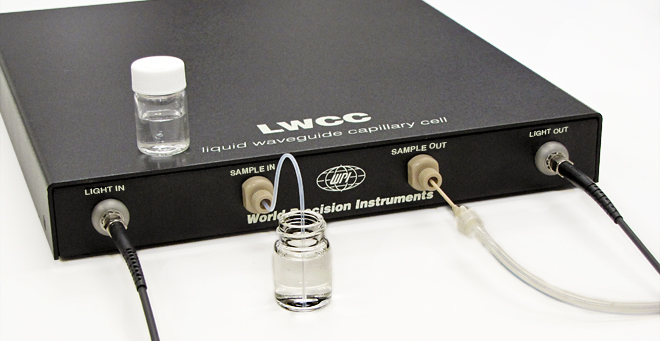LWCC-3100 100cm Liquid Waveguide Capillary Flow Cell
100CM光程長的毛細液相波導管
Item#: LWCC-3100 •250-uL Internal Sample Volume •Improve sensitivity 50 times vs standard quartz type 10-mm cuvettes. •Wavelength Range: 230-730nm

LWCC-3100 100cm Liquid Waveguide Capillary Flow Cell 100CM光程長的毛細液相波導管 Item#: LWCC-3100 •250-uL Internal Sample Volume •Improve sensitivity 50 times vs standard quartz type 10-mm cuvettes. •Wavelength Range: 230-730nm |
 |
DetailsClick here to view the current Data Sheet. Microliter sample volumes — exceptional sensitivityWPI’s Liquid Waveguide Capillary Cell (LWCC) is a flow cell for absorbance measurements in the ultraviolet, visible and near infra-red ranges. Pathlengths range from 50–500cm, with increasing measuement sensitivity from 50 to 500-fold. The flow cells are fiber coupled and have a very small sample volume ranging from 125mL (50cm pathlength) to 1,250mL (500cm pathlength). How does it work?The sample solution is introduced into the LWCC at the liquid input. Light is coupled into the LWCC from a light source via a fiber optic cable. After passing through the LWCC, light is collected with an optical fiber and guided to a detector. The concentration of the sample is determined by measuring its absorbance in the LWCC, similar to a standard UV/VIS spectrometer.
These spectra show the optimal detection limits for LWCCs of varying pathlength. Advantages of LWCC over standard cuvettesUltra-sensitive absorbance measurements can be performed in the UV, VIS, and NIR portion of the light spectrum. Compared with a standard 1cm cuvette, a 1mAU signal is enhanced 100-fold to 100mAU when using an LWCC-3100. LWCC units can be directly connected to a pump, a fluid injection analysis system, or even filled with a syringe. Detector requirementsBased on fiber optics, the LWCC is designed for use with WPI’s LEDspec (biophotometric detection system), Tidas I, Tidas 100 and Tidas E spectrometer systems. The LWCC can also be interfaced to any CCD, PDA or scanning type optical spectrometer or photodiode detector with fiber optic input capabilities. WPI also offers a range of light sources, such as FO-6000 (VIS/NIR studies) and D4H (UV/VIS) which can be used in conjunction with the LWCC. Wavelength rangeDesigned to work in the UV, VIS and NIR, the LWCC's optical performance is strongly dependent on the solvent used in the wavelength of interest. Please note that in aqueous solutions the wavelength performance is limited (see Efficiency Curves). LinearityBy Beer’s Law, the absorption of a liquid sample in LWCC bears a linear relationship to the concentration of an analyte. A linear relationship is observed between 0.01–2AU and is limited only by stray light and noise from the spectrometer. Chemical resistanceAny chemicals that could react with PEEK, Polyimide and fused silica should not be used in LWCC. (If in doubt, please contact WPI for details.) ApplicationsApplications include liquid chromatography detection, stopped-flow injection, flow-injection analysis, gas-segmented continuous flow analysis and water monitoring (environmental, oceanic, and drinking water). Please contact WPI to discuss your needs. Specifications
* Referenced using coupled 500µm fibers
When comparing light throughput versus wavelength of three fiber optic cables, the greater the diameter of the cable, the better the LWCC performance up to 500µm which is the input diameter of the SMA connector. Application Notes
Typical LWCC setup includes an injection system, a pump, and a spectrophotometer. |
||||||||||||||||||||||||||||||||||||||||||||||||||
|
WPI 台灣總代理 台灣節能企業股份有限公司 TEL:02-2715-1616;02-2716-0905 FAX:02-2715-5268 內容及版權屬節能企業及其所屬關係企業所有 All Rights Reserved By Zelon Enterprise & Associates |
||||||||||||||||||||||||||||||||||||||||||||||||||